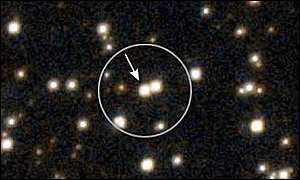There are black holes in space - bodies six times heavier than our sun - floating freely in space

For the first time, researchers have identified black holes floating freely in interstellar space. This impressive discovery is the result of a ten-year study in which ground-based telescopes searched for "gravitational lenses" in space - to clarify the nature of "dark matter".
Since several decades, astronomers have been aware of the existence of the strange phenomenon, in which matter in the universe exerts a gravitational influence on its surroundings - but it is not visible in telescopes. The nature of this substance, known as "dark matter", has not been clarified to this day and attempts to isolate one of several possible phenomena - starting with special particles and ending with planets in interstellar space - continue continuously.
One of the ways of research is to look for rare events. They are called "gravitational filtration" (from lens language). Einstein showed that light is affected by the force of gravity, and light rays bend when they pass near a body with a lot of mass. Experimental proof of this was shown in 1919 during a total solar eclipse, when the figures of the stars that were near the edge of the sun were moved from their position to a small degree, but it was measurable by the sun's gravity.
The heavier and denser a celestial body is, the greater the deflection of light rays passing by it. The heaviest bodies on the scale of a star are black holes - bodies so dense that light cannot escape from them.
When a black hole is floating in space, it can pass between us and another star that is in the background - further away from the black hole. The light of the background star passes by the black hole - and the bending of the light rays from it, under the influence of the black hole, acts like a lens: for a short period, the star becomes brighter for the observer on the ground.
Such phenomena, called "miniature gravitational obsolescence", have been known since 1996 and have been measured using many telescopes around the world. One of the telescopes participating in the research operation - in the phase of monitoring possible candidates for gravitational irradiance - is the telescope of the Israeli Weiss Observatory of Tel Aviv University, located at the Ramon Observatory.
In the gravitational lens research tens of millions of stars in space are scanned each time and their brightness is measured relative to what was known about them in the past. The brightening of some stars marks an event of gravitational recirculation. Therefore, the continuous monitoring is important to clarify whether it is a variable star, or just a real idyll. The special cases identified as a result of the passage of black holes, over the background, lasted for about 800 and about 500 days - extremely long times, relative to the bloodline renewals.
Another follow-up, using the "Hubble" space telescope, showed that the light from the background star merged, in the ground images, with the light of two other stars. The telescope's ability to separate, together with the continuous monitoring of the change of light carried out by ground telescopes, made it possible to determine the mass of the bodies that formed the gravitational lenses. These are bodies six times heavier than our sun - but at the same time, they are devoid of their own light. And they are surely black holes.
Until now, all black holes with a mass of the order of a star - have been found in double systems of stars, when they are in the center of the system where there is also a normal star (which is used as a sun). In such systems, the material from the normal star falls on the surface of the black hole - and in the process it emits light. Only in this way was it possible, until now, to conclude about the presence of a black hole.
The gravitational collapse, together with a precise measurement of the mass of the lens, makes it possible for the first time to identify black holes even when they are not members of a binary system of stars. With the addition of other cases of gravitational dusting by black holes floating freely between the stars, astronomers have at their disposal another means to estimate the amount of matter in the universe and to find out the nature of the dark matter.
